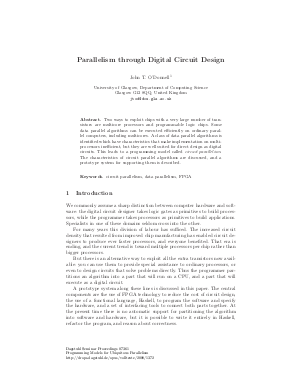Parallelism through Digital Circuit Design
Author John O'Donnell
-
Part of:
Volume:
Dagstuhl Seminar Proceedings, Volume 7361
Part of: Series: Dagstuhl Seminar Proceedings (DagSemProc) - License:
 Creative Commons Attribution 4.0 International license
Creative Commons Attribution 4.0 International license
- Publication Date: 2008-02-06
File

PDF
DagSemProc.07361.4.pdf
- Filesize: 107 kB
- 9 pages
Document Identifiers
Subject Classification
Keywords
- Circuit parallelism
- data parallelism
- FPGA
Metrics
- Access Statistics
-
Total Accesses (updated on a weekly basis)
0PDF Downloads0Metadata Views
Abstract
Two ways to exploit chips with a very large number of transistors are multicore processors and programmable logic chips. Some data parallel algorithms can be executed efficiently on ordinary parallel computers, including multicores. A class of data parallel algorithms is identified which have characteristics that make implementation on multiprocessors inefficient, but they are well suited for direct design as digital circuits. This leads to a programming model called circuit parallelism. The characteristics of circuit parallel algorithms are discussed, and a prototype system for supporting them is described.
Cite As Get BibTex
John O'Donnell. Parallelism through Digital Circuit Design. In Programming Models for Ubiquitous Parallelism. Dagstuhl Seminar Proceedings, Volume 7361, pp. 1-9, Schloss Dagstuhl – Leibniz-Zentrum für Informatik (2008)
https://doi.org/10.4230/DagSemProc.07361.4
BibTex
@InProceedings{odonnell:DagSemProc.07361.4,
author = {O'Donnell, John},
title = {{Parallelism through Digital Circuit Design}},
booktitle = {Programming Models for Ubiquitous Parallelism},
pages = {1--9},
series = {Dagstuhl Seminar Proceedings (DagSemProc)},
ISSN = {1862-4405},
year = {2008},
volume = {7361},
editor = {Albert Cohen and Mar{\'\i}a J. Garzar\'{a}n and Christian Lengauer and Samuel P. Midkiff},
publisher = {Schloss Dagstuhl -- Leibniz-Zentrum f{\"u}r Informatik},
address = {Dagstuhl, Germany},
URL = {https://drops.dagstuhl.de/entities/document/10.4230/DagSemProc.07361.4},
URN = {urn:nbn:de:0030-drops-13724},
doi = {10.4230/DagSemProc.07361.4},
annote = {Keywords: Circuit parallelism, data parallelism, FPGA}
}
